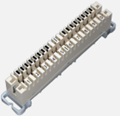Belden 9451 vs Studio Hub

[February 2024] Wiring components and consoles into a studio system is a different animal today than when you had to use one of those old “Christmas Tree” terminations. Often, though, you do have a choice of how to proceed, depending upon what products and their age/connections are available.
Over the years, I have been tasked with wiring and building many studios – sometimes many under one roof.
We bought many consoles from AudioArts/Wheatstone and Radio Systems for the Specs Howard School of Broadcasting/Media Arts in Southfield, Michigan. They were both excellent products with different design philosophies. My experience in wiring the consoles in the studios was enjoyable in that I learned of a new way to do the work, and developed preferences – which I will share – and reasons why.
Coming from a traditional broadcast background, for all analog wiring, I used Belden 9451.
A DIFFERENT APPROACH
I built and renovated 20+ studios for the Specs Howard School.
Then I learned of the concept of using Cat 5 for audio. Who could go wrong? Four twisted pairs in one jacket!
Dan Braverman of Radio Systems hosted a seminar introducing his line of StudioHub products at a Michigan Association of Broadcasters convention. The technical specs even looked good, and you could order the STP version (shielded twisted pair) of cabling if required, and it also worked for AES digital.
StudioHub included a variety of adapters and gadgets that allowed XLRs, ¼”, and the other most popular connectors in professional installations to use Cat 5 cabling more easily. The idea was to enable IT installers to wire broadcast studios since, in case you have not heard, there is a shortage of broadcast engineers.
Angry Audio now offers the Studio Hub product line, but does that force us to use them? I also have a fondness for Krone punchblocks for a full-blown installation, which seem to primarily only be available on eBay.
STUDIO HUB INSTALL
I ordered one Radio Systems console with RJ-45 connections and wired it entirely with Studio Hub adapters without active terminations.

When I wired that one StudioHub studio, I did not save any time, but keeping all my Cat 5 connections passive was a good thing.
In the meantime, console manufacturers like Arrakis and AudioArts seem to have accepted the RJ-45 as their standard interface, at least for some of their boards.
One of the dirty little secrets of StudioHub is they used “unused pairs” in the Cat 5 to carry supply Voltages to the various interface boxes. It was a good idea at the time, but if the installing engineer did not leave documentation, you might not know which connectors carry both audio and supply voltage.
If you unknowingly plug a StudioHub cable directly into a piece of equipment without that knowledge, you can and will damage or destroy the equipment, inserting 12 Volts DC or whatever into a place it does not belong.
That in itself is not the real problem if you just test every unknown cable.
SOMETHING TO CONSIDER
The real problem is one which plagues all equipment and connectors: Oxidation and age – and StudioHub adapters are not immune.
Angry Audio now offers the StudioHub product line, but does that force us to use them? No.
For a full-blown installation, I also have a fondness for Krone punch blocks, which these days, seem to primarily be available only on eBay.

What I did for an installation at the Star International Academy, a local charter school’s new station was to order a bunch of standard Cat 5 cables, cut them in half, then punch the cut ends to a Krone block. From the block to the source equipment, I used standard Belden audio cable.
There must be a better way in an existing studio, right ?
There is.
HALF AND HALF
MPJA.com offers RJ-45 adapters which terminate with euroblock style connectors.

Depending on your Angry Audio vendor, they are about 1/4th or 1/5th the cost of the equivalent StudioHub product and take up less space. There are also no flexible cables involved.
If you have a studio that has not had major renovations for many years but had used StudioHub, this is a good alternative approach.
YOU HAVE CHOICES
If you want to keep the existing technology, you still can go to the Angry Audio StudioHub page.
Or, if you want – or need – to save on the budget, you can always use one of the two alternate methods described. Search for some Krone blocks or check out the euroblock connectors.
– – –
Bob Burnham is Production Director and Chief Engineer at WHFR-FM, the Public station of Henry Ford College, Dearborn Michigan and has been in the broadcast business over 40 years. You can contact Bob at bob@brcbroadcast.com
– – –
Would you like to know when more articles like this are published? It will take only 30 seconds to
click here and add your name to our secure one-time-a-week Newsletter list.
Your address is never given out to anyone.
– – –
